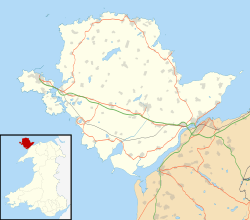Bryn Gwyn stones facts for kids

Bryn Gwyn slab stone
|
|
| Location | Brynsiencyn, Anglesey, Wales |
|---|---|
| Region | Great Britain |
| Coordinates | 53°10′38″N 4°18′08″W / 53.177174°N 4.302127°W |
| Type | Stone circle |
| Height | 4m |
| History | |
| Material | stone |
| Periods | Neolithic |
| Site notes | |
| Excavation dates | 2010 |
| Archaeologists | Gwynedd Archaeological Trust |
| Public access | Yes |
| Reference no. | AN022 |
The Bryn Gwyn stones are two very old, tall stones. They stand on the Isle of Anglesey in Wales. These stones are about 280 metres southwest of Castell Bryn Gwyn. They sit on a low ridge, about 2 metres above the Afon Braint valley.
Contents
Discovering the Bryn Gwyn Stones
These stones are the tallest standing stones in Wales. They are nearly 4 metres high! In 1723, a person named Henry Rowlands wrote about them. He said they were part of a broken circle of eight stones. This circle was about 16 metres wide.
What Happened to the Stones?
An old story from 1797 says that local people thought money was hidden under the stones. They dug them up to find it. Today, only two stones are still standing. One is a flat slab, and the other is a tall pillar. They are now part of a modern field fence.
Finding Hidden Clues
Even though most stones are gone, archaeologists found clues. In 2008, they dug around the area. They found three pits where standing stones used to be. Two of these pits still had parts of the old stones inside. This matched what Henry Rowlands had written. More digging in 2010 found pits for three more missing stones. This means seven of the original eight stones have been located.
The Stones and the Sun
One of the stone pits was for a special 'blade-style' stone. This stone was lined up with the sun. It pointed to where the sun rises during the summer solstice. It also pointed to where the sun sets during the winter solstice. This shows that ancient people used these stones to track the sun's path.
A Path to the Past
You can visit the Bryn Gwyn stones today. A public path goes right past them. From the stones, you can see the midsummer sun rise over the middle of Castell Bryn Gwyn. This old fort is further along the path.
Life Around the Stones
In the 1700s, a small house was built right next to the wide stone. The stone was used as one of the house's walls. You can still see marks on top of the stone where the roof beams used to fit. After the house was taken down, the stones were used as a gate for the field.
Other Lost Circles
Further northeast, at a place called Tre'r Dryw Bach, there was another large stone circle. Visitors in the 1700s wrote about it. But this stone circle has also been removed over time.


